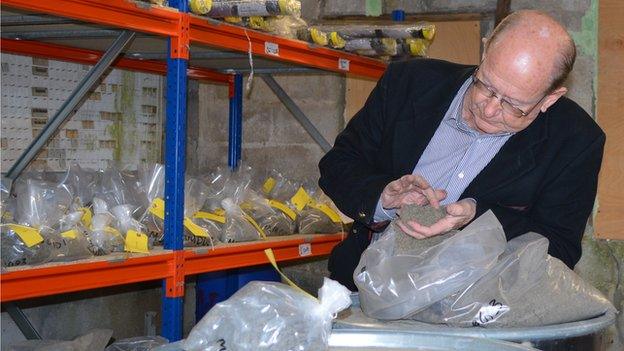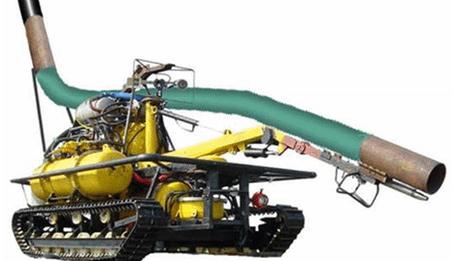Cornwall tin mining plans create deep divisions
- Published

Tin man: Mike Proudfoot sifts the sands which environmentalists say must be protected
"They have left us half of their tin," says mining engineer Mike Proudfoot as he examines a bag of sand taken from the north Cornwall coast.
He is aiming to extract tin from the sands which are rich in waste, or "tailings", from the old mines around Cornwall.
During the 18th and 19th Centuries, Cornwall was one of the most important and influential metal mining regions in the world.
There are no working mines now, but that could be about to change with a resurgence in the price of tin, used as a solder on gadgets like phones and computers.
'Very rosy'
"It is now a high-tech mineral," said Mr Proudfoot, director of Marine Minerals Ltd (MML). "It is not just tin cans any more.
"It looks very rosy as far as we are concerned."

MML is working on designs for a crawler-based vehicle to suck up the sand
MML is searching the seabed off Cornwall for the tin tailings which were washed down there from the old mines.
It believes that about 40% of the tin mined on land is now sitting on the seabed.
The firm's plan is to sift the seabed at least 200m from the low water mark off the coast at St Ives Bay, Porthtowan and Perran.
According to MML, the extraction process will involve up to three tracked vehicles on the seabed sucking up the sand for sifting on a ship.

Waste tin, or "tailings", were washed into the sea from old mines in Cornwall
The Cornwall-based firm is proposing to sift 2m tonnes of sand from the seabed every year for 10 years, with about 95% of that material going straight back onto the seabed.
The rest will be taken ashore to produce about 1,000 tonnes of tin a year, with the waste possibly going into old clay pits in the St Austell area.
But the plans are opposed by environmental groups and surfers who say it will destroy the natural habitat and the beach breaks.
MML rejects the arguments and has launched a £500,000 environmental assessment before making an extraction licence application to the Marine Management Organisation (MMO).
An initial "scoping" report by MML has raised questions from the MMO about the impact on the environment.
The proposed extraction areas are near to a number of designated or proposed Sites of Special Scientific Interest and other protected sites.
The MMO's concerns in its response include the affect on:
Marine life such as oysters and sea snails around Perran which is a proposed Marine Conservation Zone.
St Ives Bay, an "important" migratory route and feeding area for sea trout and Atlantic salmon.
Shell-fish production in St Ives Bay
The stirring up of heavy metals on the seabed and an increase in algal blooms
Tourism due to noise close to the shore
The £64m local surfing industry
"The material we reject at sea goes down a pipe and back into the trench that we have just drilled," said Mr Proudfoot.
"It's like planting a cable in a field, it digs a trench, puts the cable in and covers it up."
Mr Proudfoot does not like the word dredging, which "leaves a large scar on the seabed", being applied to MML's plans.
Indeed, he is hoping MML's tin extraction methods will be a template for other offshore mining operations around the world which are facing environmental concerns.
But Andy Cummins of campaigners Surfers Against Sewage (SAS) said: "If you are going to remove several million tonnes of sand 200m from the shoreline that environment will be destroyed.
"When you return the sand it will smother everything in that area.

Surfing campaigners fear the effect of tin extraction on "iconic" Cornish beaches
"It will be devastating for things living on the seabed."
SAS is also concerned about the affect on seals, dolphins and basking sharks.
MML says its plans will create 100 jobs, but SAS maintains that more jobs could be lost in tourism as well as among the 1,600 employed in the surfing industry.
SAS said some of the most "iconic" surfing beaches in Cornwall - St Ives, Carbis Bay, Mexico, Gwithian, Godrevy, Portreath, Porthtowan, Chapel Porth, Trevaunance Cove, St Agnes, Perranporth - were in the areas being targeted by MML.
"Sand is the very thing that surfing waves need," said Mr Cummins.
Mining 'promising'
Spurred by tin prices of about $20,000 (£13,300) a tonne, MML has been joined in Cornwall by UK exploration company Treliver Minerals which is test drilling for tin at Treliver Farm, near St Columb Major.
And at Callington there are plans by Australian mining firm New Age Exploration to re-open the historic Redmoor mine., external
Professor Frances Wall, head of Camborne School of Mines (CSM) in Cornwall, said there could be a long-term resurgence in Cornish tin mining.
"The tin mines only closed down because the price of tin went down, not because there was no tin left in the ground," she said.
"Tin prices are high now, so it looks promising again.
"They (MML) have a big job to sort out the environmental impact, but Cornwall is pretty pro-mining because of its heritage.
"Mining is also an important economic activity, so companies have a bit of a head start."
MML said it expects to make its application by early next year after which it will go through a public consultation before the MMO makes a decision.
- Published14 March 2013
- Published15 May 2013
- Published18 May 2013
- Published21 April 2013
- Published25 April 2013
- Published7 February 2013
- Published14 July 2012
- Published5 July 2011